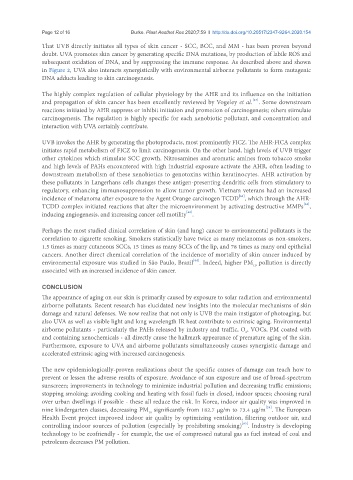Page 79 - Read Online
P. 79
Page 12 of 16 Burke. Plast Aesthet Res 2020;7:59 I http://dx.doi.org/10.20517/2347-9264.2020.154
That UVB directly initiates all types of skin cancer - SCC, BCC, and MM - has been proven beyond
doubt. UVA promotes skin cancer by generating specific DNA mutations, by production of labile ROS and
subsequent oxidation of DNA, and by suppressing the immune response. As described above and shown
in Figure 2, UVA also interacts synergistically with environmental airborne pollutants to form mutagenic
DNA adducts leading to skin carcinogenesis.
The highly complex regulation of cellular physiology by the AHR and its influence on the initiation
[47]
and propagation of skin cancer has been excellently reviewed by Vogeley et al. . Some downstream
reactions initiated by AHR suppress or inhibit initiation and promotion of carcinogenesis; others stimulate
carcinogenesis. The regulation is highly specific for each xenobiotic pollutant, and concentration and
interaction with UVA certainly contribute.
UVB invokes the AHR by generating the photoproducts, most prominently FICZ. The AHR-FICA complex
initiates rapid metabolism of FICZ to limit carcinogenesis. On the other hand, high levels of UVB trigger
other cytokines which stimulate SCC growth. Nitrosamines and aromatic amines from tobacco smoke
and high levels of PAHs encountered with high industrial exposure activate the AHR, often leading to
downstream metabolism of these xenobiotics to genotoxins within keratinocytes. AHR activation by
these pollutants in Langerhans cells changes these antigen-presenting dendritic cells from stimulatory to
regulatory, enhancing immunosuppression to allow tumor growth. Vietnam veterans had an increased
[61]
incidence of melanoma after exposure to the Agent Orange carcinogen TCDD , which through the AHR-
[62]
TCDD complex initiated reactions that alter the microenvironment by activating destructive MMPs ,
[63]
inducing angiogenesis, and increasing cancer cell motility .
Perhaps the most studied clinical correlation of skin (and lung) cancer to environmental pollutants is the
correlation to cigarette smoking. Smokers statistically have twice as many melanomas as non-smokers,
1.5 times as many cutaneous SCCs, 15 times as many SCCs of the lip, and 78 times as many oral epithelial
cancers. Another direct chemical correlation of the incidence of mortality of skin cancer induced by
[64]
environmental exposure was studied in São Paulo, Brazil . Indeed, higher PM pollution is directly
10
associated with an increased incidence of skin cancer.
CONCLUSION
The appearance of aging on our skin is primarily caused by exposure to solar radiation and environmental
airborne pollutants. Recent research has elucidated new insights into the molecular mechanisms of skin
damage and natural defenses. We now realize that not only is UVB the main instigator of photoaging, but
also UVA as well as visible light and long wavelength IR heat contribute to extrinsic aging. Environmental
airborne pollutants - particularly the PAHs released by industry and traffic, O , VOCs, PM coated with
3
and containing xenochemicals - all directly cause the hallmark appearance of premature aging of the skin.
Furthermore, exposure to UVA and airborne pollutants simultaneously causes synergistic damage and
accelerated extrinsic aging with increased carcinogenesis.
The new epidemiologically-proven realizations about the specific causes of damage can teach how to
prevent or lessen the adverse results of exposure. Avoidance of sun exposure and use of broad-spectrum
sunscreen; improvements in technology to minimize industrial pollution and decreasing traffic emissions;
stopping smoking; avoiding cooking and heating with fossil fuels in closed, indoor spaces; choosing rural
over urban dwellings if possible - these all reduce the risk. In Korea, indoor air quality was improved in
[28]
nine kindergarten classes, decreasing PM significantly from 182.7 μg/m to 73.4 μg/m . The European
10
Health Event project improved indoor air quality by optimizing ventilation, filtering outdoor air, and
[65]
controlling indoor sources of pollution (especially by prohibiting smoking) . Industry is developing
technology to be ecofriendly - for example, the use of compressed natural gas as fuel instead of coal and
petroleum decreases PM pollution.

